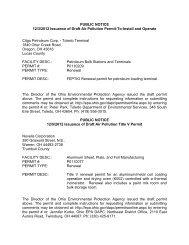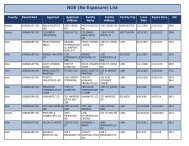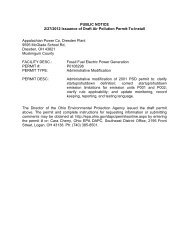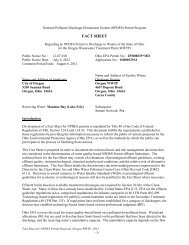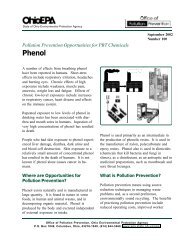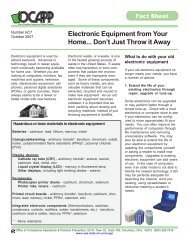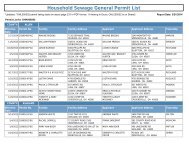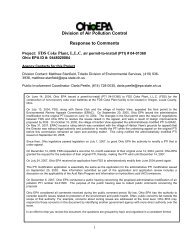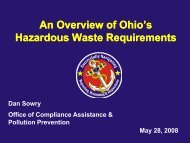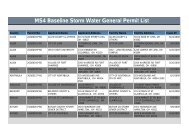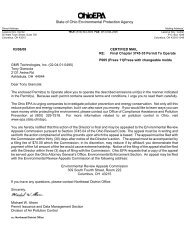Mercury Spill Response & Clean-up Guidance Document - Ohio EPA
Mercury Spill Response & Clean-up Guidance Document - Ohio EPA
Mercury Spill Response & Clean-up Guidance Document - Ohio EPA
- No tags were found...
You also want an ePaper? Increase the reach of your titles
YUMPU automatically turns print PDFs into web optimized ePapers that Google loves.
<strong>Mercury</strong> <strong>Spill</strong><strong>Response</strong> &<strong>Clean</strong>-<strong>up</strong><strong>Guidance</strong><strong>Document</strong>OSPPERAP.O. Box 261045Columbus, <strong>Ohio</strong> 43226-1045© OSPPERA, 2002
DisclaimerThe purpose of this document is not to replace any previous work performed onguidance document development regarding mercury spill response and/orclean<strong>up</strong>, but rather be consistent with and compatible with existing documents,specifically, U.S. <strong>EPA</strong>, Region-5 <strong>Mercury</strong> <strong>Response</strong> Guidebook.This guidance document does not replace formal training and/or education anddoes not purport to address every situation where mercury may be present orspilled.The information contained herein is based <strong>up</strong>on data believed to be reliable, butis provided without any guarantee or warranty of any kind, either expressed orimplied and <strong>Ohio</strong> <strong>Spill</strong> Planning, Prevention and Emergency <strong>Response</strong>Association (OSPPERA) disclaim any liability incurred from the use thereof.The products and mercury described herein should be stored, handled and usedin accordance with municipal, state and federal laws and regulations.3
AcknowledgementsOSPPERA wishes to thank the following individuals who have provided technicaldata, methods and techniques and/or review of this <strong>Guidance</strong> <strong>Document</strong>: Theirassistance has been invaluable throughout the development of this document.Dan Swanson, Porter, Wright, Morris & ArthurJim Crawford, On-Scene Coordinator, <strong>Ohio</strong> <strong>EPA</strong>, SWDODale Farmer, On-Scene Coordinator, <strong>Ohio</strong> <strong>EPA</strong>, SWDOBill Narotski, Chair, <strong>Ohio</strong> <strong>Mercury</strong> Reduction Gro<strong>up</strong>, <strong>Ohio</strong> <strong>EPA</strong>Dave Heinlen, Bowling Green State UniversityMark Durno, On-Scene Coordinator, U.S. <strong>EPA</strong>, Region 5Mike Gerber, On-Scene Coordinator, <strong>Ohio</strong> <strong>EPA</strong>, NWDOLise Mercier, Marketing & Sales Director, EPS-RossDick Girman, Marketing Director, Minuteman Vacuum SystemsMark Zalutko, Technical Assistant, Acton TechnologiesJenny Pierce, Customer Service, Nilfisk-AdvanceEric Yates, <strong>Ohio</strong> Department of HealthAdditionally, the Board of Directors of OSPPERA has provided guidance anddirection for our members and has provided additional s<strong>up</strong>port throughout thedevelopment of this document.Joel Hogue, Executive Director & PresidentJim Crawford, Vice PresidentRoy Bumpass, Secretary/TreasurerDan Swanson, General CounselGrant Dalton, DirectorBarney Cook, Director4
<strong>Mercury</strong> Reduction and <strong>Spill</strong> Planning & PreventionEvery effort should be made to prevent a mercury spill from occurring due to thehealth effects of mercury vapor, the cost associated with the clean-<strong>up</strong> and thedifficulty in removing mercury vapor from certain areas. The best way to preventa release of elemental mercury is not to have it! Proper disposal or reclamationof the mercury is strongly recommended. If you must keep mercury-containingdevices, please follow these precautionary measures• Always store mercury in unbreakable container.• Store in well-ventilated area.• When using mercury-containing devices, do so over plastic containmenttray. Make sure container is of sufficient size to contain the greatestamount of mercury that may be spilled.• Transfers of mercury should be done under an appropriate exhaust hoodand over a plastic containment tray. Make sure container is of sufficientsize to contain the greatest amount of mercury that may be spilled.• Maintain an appropriate spill kit in area where mercury is used or stored.Know and follow all manufacturer directions.• Whenever possible, choose non-mercury containing devices.• If you use fluorescent lights, remember they are considered universalwaste and should be managed as such (40 CFR 273). (Note: Citizensare exempt.)• Work surfaces should have few crevices and carpeted areas should neverbe used.• Appropriate training is required for anyone working with or cleaning <strong>up</strong> amercury spill.• Have written spill plan for mercury releases, practice and <strong>up</strong>date often.6
Defining <strong>Mercury</strong> <strong>Spill</strong> Size & Suggested Definitions<strong>Spill</strong> SizeSmall <strong>Spill</strong> (Contained):Small <strong>Spill</strong> (Spread out):Large <strong>Spill</strong>:A spill that may result from a broken thermometer orthermostat. The amount of mercury contained inthese devices is usually around 3 grams.A spill that may result from a broken thermometer orthermostat. This spill has spread out either by thebeads of mercury breaking apart <strong>up</strong>on impact withanother surface or by tracking either by humans oranimals. This spill usually is confined to one roomand the impacted area may cover <strong>up</strong> to 50 squarefeet.A spill from any source of mercury that involvesmultiple rooms, buildings, motor vehicles or where theimpacted area covers more than 50 square feet.Suggested Definitions<strong>Clean</strong> Area:Restricted Area:Controlled Area:Where mercury vapor is demonstrated to maintainedbelow 1 µg/m 3 for no less than 4 consecutive hoursfollowing adequate and appropriate decontaminationprocedures. (ATSDR Residential Occ<strong>up</strong>ancy Level)Where mercury vapor levels exceed 1 µg/m 3 but lessthan 10 µg/m 3 . An approved APR with mercury vaporcartridges should be worn in these areas.Where mercury vapor levels exceed 10 µg/m 3 . Anapproved SCBA should be worn in these areas.7
Types, Sources and Properties of <strong>Mercury</strong>Metallic <strong>Mercury</strong> (Elemental <strong>Mercury</strong>)• Shiny, silver-white metal that exists as a liquid at room temperature.• Expands and contracts evenly with temperature changes.• Highly toxic.• Readily vaporizes at or near 55°F.• Reaches gaseous state at 300°C.• Alloys with copper, silver, nickel, gold and zinc to form amalgam.• Bioaccumulates in humans, animals and the environment.• Found in thermometers, barometers, thermostats, pressure gauges,dental offices, blood pressure devices, fluorescent light bulbs and sometennis shoes that light <strong>up</strong>.• Very high level of electrical conductivity (but has no charge), used inbatteries, rectifiers, oscillators, power control switches and vapor lamps.• Is not water-soluble.• Used in the production of chlorine gas (amalgamates with sodium insodium chloride), caustic soda and gold extraction.• Used in the production of paint• Medicinals: Used primarily in dental offices for cavity filling.• Herbal and religious remedies in Latin America, Asia and Caribbean. Soldunder the name “Azogue”.• Vapor can accumulate in wall spaces, attics, etc.• Vapor can accumulate in electronic equipment, especially computers.<strong>Mercury</strong> re-vaporizes when device is turned on and heat is generated.IdentificationSymbol:HgCAS Number: 7439-97-6Atomic Weight: 200.59Boiling Point: 674 o FSolubility in Water: InsolubleSpecific Gravity: 13.6 (metal)Vapor Pressure: 0.0012 mm HgFreezing Point: -38 o FVapor Density: 7.0Appearance: Silvery-White, heavy, mobile, and liquid metal8
Inorganic <strong>Mercury</strong>• Also called mercury salts.• Occurs when mercury combines with elements such as chlorine, sulfurand oxygen.• Most are white powders and/or crystals.• Ionized.• Easily associates with particles and water in the atmosphere.• Used for fungicides and skin lighting creams.Organic <strong>Mercury</strong>• Formed when mercury combines with carbon.• Most common form is methyl mercury.• Form most available to zooplankton, insects, fish, and humans.• Bioaccumulates in tissues.• Volatile.• Water-soluble.9
Health EffectsVery high exposures to mercury vapor can cause acute poisoning and/or death.Symptoms usually begin with cough, chest tightness, difficulty breathing and<strong>up</strong>set stomach.Acute inhalation of mercury vapor may result in chills, nausea, general malaise,tightness in the chest, chest pain, difficulty breathing, cough, kidney damage,stomatitis, gingivitis, salivation, diarrhea and death.<strong>Mercury</strong> is considered a poison and the routes of exposure include inhalation,ingestion and absorption. The most common route of exposure for elementalmercury is inhalation. The most common route for of exposure for organicmercury is ingestion.<strong>Mercury</strong> has a delayed burning sensation to the skin and eye of several minutes<strong>up</strong> to several hours.The central nervous system is very sensitive to mercury vapor. Chronicexposure is characterized by behavior changes, weakness, fatigue, weight loss,gastro-intestinal dysfunction, tremors in fingers, eyelids and lips, memory loss,insomnia and depression.10
Medical MonitoringTaken from OSHA Technical Link, Occ<strong>up</strong>ation Safety and Health Guideline for<strong>Mercury</strong> Vapor, Revision Date: 27 April 1999.MEDICAL SURVEILLANCEOSHA is currently developing requirements for medical surveillance. When theserequirements are promulgated, readers should refer to them for additionalinformation and to determine whether employers whose employees are exposedto mercury vapor are required to implement medical surveillance procedures.* Medical ScreeningWorkers who may be exposed to chemical hazards should be monitored in asystematic program of medical surveillance that is intended to preventocc<strong>up</strong>ational injury and disease. The program should include education ofemployers and workers about work-related hazards, early detection of adversehealth effects, and referral of workers for diagnosis and treatment. Theoccurrence of disease or other work-related adverse health effects should promptimmediate evaluation of primary preventive measures (e.g., industrial hygienemonitoring, engineering controls, and personal protective equipment). A medicalsurveillance program is intended to s<strong>up</strong>plement, not replace such measures. Todetect and control work-related health effects, medical evaluations should beperformed (1) before job placement, (2) periodically during the term ofemployment, and (3) at the time of job transfer or termination.* Pre-placement medical evaluationBefore a worker is placed in a job with a potential for exposure to mercury vapor,a licensed health care professional should evaluate and document the worker'sbaseline health status with thorough medical, environmental, and occ<strong>up</strong>ationalhistories, a physical examination, and physiologic and laboratory testsappropriate for the anticipated occ<strong>up</strong>ational risks. These should concentrate onthe function and integrity of the eyes, skin, respiratory system, central andperipheral nervous systems, and kidneys. Medical surveillance for respiratorydisease should be conducted using the principles and methods recommended bythe American Thoracic Society. A pre-placement medical evaluation isrecommended to assess medical conditions that may be aggravated or mayresult in increased risk when a worker is exposed to mercury vapor at or belowthe prescribed exposure limit. The health care professional should consider theprobable frequency, intensity, and duration of exposure as well as the nature anddegree of any applicable medical condition. Such conditions (which should notbe regarded as absolute contraindications to job placement) include a history andother findings consistent with diseases of the eyes, skin, respiratory system,central and peripheral nervous systems, or kidneys.* Periodic medical evaluationsOcc<strong>up</strong>ational health interviews and physical examinations should be performedat regular intervals during the employment period, as mandated by any11
applicable Federal, State, or local standard. Where no standard exists and thehazard is minimal, evaluations should be conducted every 3 to 5 years or asfrequently as recommended by an experienced occ<strong>up</strong>ational health physician.Additional examinations may be necessary if a worker develops symptomsattributable to mercury vapor exposure. The interviews, examinations, andmedical screening tests should focus on identifying the adverse effects ofmercury vapor on the eyes, skin, respiratory system, central and peripheralnervous systems, or kidneys. Current health status should be compared with thebaseline health status of the individual worker or with expected values for asuitable reference population.* Termination medical evaluationsThe medical, environmental, and occ<strong>up</strong>ational history interviews, the physicalexamination, and selected physiologic or laboratory tests that were conducted atthe time of placement should be repeated at the time of job transfer ortermination to determine the worker's medical status at the end of his or heremployment. Any changes in the worker's health status should be compared withthose expected for a suitable reference population.* Biological monitoringBiological monitoring involves sampling and analyzing body tissues or fluids toprovide an index of exposure to a toxic substance or metabolite. No biologicalmonitoring test acceptable for routine use has yet been developed for mercuryvapor. However, total inorganic mercury can be measured in the urine by preshiftsampling. A mercury level of 35 micrograms per gram of creatinine should beused as the biological exposure index. In addition, total inorganic mercury canalso be measured in the blood by sampling at the end of shift at the end of theworkweek. A mercury level of 15 micrograms per liter of blood should be used asthe biological exposure index.12
Taken from CPL 2-2.6 OSHA Instruction October 30, 1978, OSHA ProgramDirective #300-2, Inorganic <strong>Mercury</strong> and Its CompoundsMEDICAL SURVEILLANCEEach employer should institute a medical surveillance program for all employeeswho are or will be exposed to airborne concentrations of mercury vapor or thedust of its inorganic compounds above the permissible exposure limit. Theprogram should provide each employee with an opportunity for biologicalmonitoring and medical examination performed by or under the s<strong>up</strong>ervision of alicensed physician and provided during the employee's normal working hourswithout cost to the employee.Medical Examinationa. Each employer should provide a medical examination which includes acomplete medical history and physical examination, complete blood count,routine urinalysis (specific gravity, sugar, protein determinations, andmicroscopic examination), and voluntary pregnancy test, whereappropriate, to each employee exposed to mercury or its inorganiccompounds in excess of the permissible exposure limit.b. Medical examinations should also be made available:i. To employees prior to their assignment to areas in whichairborne concentrations of mercury or its inorganiccompounds are above the permissible exposure limit;ii. At least annually for each employee exposed to airborneconcentrations of mercury or its inorganic compounds abovethe permissible exposure limit at any time during thepreceding six months;iii. For each employee whose urine analysis sampling seriesindicates elemental mercury level at or above 0.02 mg perliter of urine or total mercury level in excess of .200 mg perliter of urine, which is not receding;iv. Immediately <strong>up</strong>on notification by the employee that theemployee has developed signs or symptoms commonlyassociated with toxic exposure to inorganic mercury or itscompounds.c. Where medical examinations are performed, the employer should providethe examining physician with the following information:i. The reason for the medical examination requested;ii. A description of the affected employee's duties as they relateto the employee's exposure;iii. A description of any personal protective equipment used orto be used;iv. The results of the employee's exposure measurements, ifavailable;v. The employee's anticipated or estimated exposure level;vi. The results of the employee's biological monitoring; and13
Biological Monitoringvii. Upon request of the physician, information concerningprevious medical examination of the affected employee.Urine sampling and analysis should be the biological monitoring method used.The method of analysis for total, ionic and elemental mercury in urine isdescribed in the American Industrial Hygiene Association Journal, September1974, pp. 576-580. For the analysis at least 100 ml of urine should be collectedduring a workday when sampling is scheduled.Accuracy of Measurement. Sample analysis should have an accuracy to aconfidence level of 95% as it pertains to the repeatability of several analysesfrom any given urine sample.Frequency of Monitoring (a) If possible, a urine sample should be obtained of allemployees who will be assigned to work with mercury or its inorganic compoundsprior to exposure to the work area. (b) For employees exposed to less thanpermissible levels of airborne mercury, urine sampling and analysis should bedone every six months. (c) For employees exposed to airborne mercury vapor orinorganic mercury compounds above the permissible exposure limit, urinesampling and analysis should be performed every three months for eachemployee. It should continue at least six months after the last known exposureabove the permissible exposure limit if the employee is available for sampling. (d)Where the total mercury level exceeds .200 mg of mercury per liter of urine, or0.02 mg of elemental mercury per liter of urine, sampling should be acceleratedto a weekly basis. The activities of the employees should be observed to detectthe potential source of mercury intake. (e) If the total mercury level in urine doesnot decrease during the one-month sampling period, or if the elemental mercurylevel in urine does not decrease in two weeks, a physician should be consulted.The results of employee urine sampling should also be considered as a gro<strong>up</strong>exposure by area of assignment and/or by job description. Elevated gro<strong>up</strong> urinemercury levels should be a cause for review of operational practices, processcontrols, and a change in either or both to reduce employee exposures. If severalemployee urine samples from the same area of assignment indicate excessiveelemental mercury urine levels, the employer should start corrective action in thearea immediately.Physician's Written OpinionThe employer should obtain and furnish the employee with a written opinion fromthe examining physician containing the following: (a) The signs or symptoms ofmercury exposure manifested by the employee, if any; (b) A laboratory report ofthe mercury content in blood or urine if such analysis is performed by or underthe s<strong>up</strong>ervision of the physician, or reported to the physician by a laboratory towhich such samples have been submitted for analysis; (c) The physician's14
opinion as to whether the employee has any detected risk of material impairmentto the employee's health from exposure to mercury or its inorganic compounds orwould directly or indirectly aggravate any detected medical condition; (d) Anyrecommended limitation <strong>up</strong>on the employee's exposure to mercury or itsinorganic compounds or <strong>up</strong>on the use of personal protective equipment andrespirators; and (e) A statement that the employee has been informed by thephysician of any medical condition which requires further examination ortreatment. (ii) The written opinion obtained by the employer should not revealspecific findings or diagnoses unrelated to occ<strong>up</strong>ational exposure to mercury orits inorganic compounds. (iii) If the employer determines, on the basis of thephysician's written opinion, that any employee's health would be materiallyimpaired by maintaining the existing exposure to mercury or its inorganiccompounds, the employer should place specific limitations, based on thephysician's written opinion, on the employee's continued exposure to mercury orits inorganic compounds.15
Agency Jurisdiction & Notification<strong>Ohio</strong> <strong>EPA</strong>:U.S. <strong>EPA</strong>:SARA (Title III):US DOT:Reportable Quantity, One (1) poundReportable Quantity, One (1) poundTCLP: (RCRA) 2 mg/lUnderlying Hazardous Constituent: 0.025 mg/l TCLPTSCA: 250 mg/kgNot subject to reporting requirementsReportable Quantity, One (1) poundCorrosive labels requiredMust be shipped in conformance with HM 181Performance Oriented Packaging StandardsDOT Number: UN2809ERG Number: 172Telephone Numbers<strong>Ohio</strong> <strong>EPA</strong>: 800-282-9378Local Health Department:See OSPPERA DirectoryLocal EMA/LEPC:See OSPPERA DirectoryATSDR, Emergency <strong>Response</strong> Hotline: 404-639-0615ATSDR, General Information: 800-447-1544National <strong>Response</strong> Center: 800-424-8802S<strong>up</strong>erfund Information Hotline: 800-424-9346Local Poison Control Center:See local telephone book<strong>Ohio</strong> Department of Health 614-466-139016
Measurement of concentrations in air:Understanding Units of MeasureConcentrations of chemicals in air are measured in units of the mass ofthe chemical per volume of air in cubic Meters (m 3 ). One (1) cubic Meter(m 3 ) equals 35.31 cubic feet.1 milligram (mg) = 1/1,000 gram1 microgram (µg) = 1/1,000,000 gram1 nanogram (ng) = 1/1,000,000,000 gram1 milligram (mg) = 10,000 nanograms (ng)1 microgram (µg) = 1,000 nanograms (ng)1 nanogram (ng) = 1.0 nanogram (ng)Exposure LimitsACGIH TWA/TLV 0.025 mg/m³ Normal 8 hour workday & 40 hour workweekOSHA PEL 0.1 mg/m³ At no time can this level be exceededOSHA IDLH 10 mg/m³ Immediately Dangerous to Life & HealthNIOSH REL 0.05 mg/m³ 10 hour workday & 40 hour workweek***There is also a skin designation for mercury exposure***Suggested Action Levels for <strong>Mercury</strong> (ATSDR)ATSDR MRL 0.2 µg/m³ Minimal Risk LevelATSDR ROL < 1.0 µg/m³ Level acceptable for occ<strong>up</strong>ancy of anystructure after a spill. (ResidentialOcc<strong>up</strong>ancy LevelATSDR 10 µg/m³ Isolate residents from exposure10 µg/m³ Acceptable level in a modified testprocedure to allow personal effects toremain in the owner’s possessionATSDR 3.0 µg/m³ Re-occ<strong>up</strong>ancy after a spill of anocc<strong>up</strong>ational or commercial setting wheremercury is not usually handledATSDR 25 µg/m³ Occ<strong>up</strong>ational settings where mercury ishandledATSDR 25 µg/m³ <strong>Response</strong> Worker Protection EquipmentUpgradeATSDR 10,000 µg/m³ Immediately Dangerous to Life & Health17
Minimum <strong>Response</strong> Equipment & Personnel• OSHA 40 Hour, General Site Worker trained personnel (minimum 2).• Approved mercury specific vacuum in good working order and properlymaintained.• Personnel Protective Equipment• Minimum OSHA Level C: The concentration(s) and type(s) of airbornesubstance(s) is known and the criteria for using air-purifying respiratorsare met. The following constitute Level C equipment; it may be usedas appropriate.• Full-face or half-face air purifying respirator, NIOSHapproved. <strong>Mercury</strong> vapor cartridges with end-of-lifeindicator.• Hooded, chemical resistant clothing (coveralls; disposablechemical-resistant overalls)• Coveralls (optional, as applicable)• Gloves, chemical resistant outer• Gloves, chemical resistant inner• Boots, chemical resistant outer with steel toe & shank(optional, as applicable)• Boots, chemical resistant outer, disposal (optional, asapplicable)• Hard Hat (optional, as applicable)• Escape mask (optional, as applicable)• Face shield (optional as applicable)• Personal Protective Equipment• If mercury vapor concentrations exceed 25 µg/m³ OSHA Level Bshould be utilized. The highest level of respiratory protection isnecessary but a lesser level of skin protection is needed.• Positive pressure, full-face piece self-contained breathingapparatus (SCBA), or positive pressure s<strong>up</strong>plied air respiratorwith escape SCBA (NIOSH Approved)• Hooded, chemical-resistant clothing (overalls and long-sleevedjacket; coveralls; one or two piece chemical-splash suit;disposable chemical-resistant overalls)• Coveralls (optional, as applicable)• Gloves, outer, chemical resistant• Gloves, inner, chemical resistant• Boots, outer, chemical resistant steel toe and shank• Boots-covers, outer, chemical resistant (disposable) (optional,as applicable)• Hard hat (optional, as applicable)• Face shield (optional, as applicable)18
• <strong>Mercury</strong> amalgamating product• <strong>Mercury</strong> vapor s<strong>up</strong>pressant• Ventilation fans & extension cords• Duct Tape• Large trash bags or drum liners• <strong>Mercury</strong> Vapor Analyzer• Spray bottles• Propane, gas or electric heater• Thermometer (non-mercury containing)• <strong>Clean</strong> 1 or 5 gallon buckets• <strong>Clean</strong> brushes (for applying amalgam paste)• Razor Knives (for carpet removal)• Scrapers (for carpet removal)• Plastic container (for recovered elemental mercury)• DOT approved shipping containers (for waste material)• Mop & bucket• Flashlight (with optional red lens)• Plastic dust pan (small)• Eye dropper• Plastic coated playing cards• Zip top plastic baggies• Plastic sheeting• Typical chemical decontamination s<strong>up</strong>plies (pools, brushes, etc.)Special Notice on APR use with <strong>Mercury</strong> Vapor CartridgesBecause mercury vapors are colorless and odorless, “end-of-service-life”indicators must be incorporated into the mercury vapor cartridges being used andmust be readily visible to the user without manipulation while wearing therespirator. DO NOT USE APR when concentrations of mercury vapor areimmediately dangerous to life and health, are unknown, or when theconcentration exceeds 10 times the PEL with half-face respirators or 50 times thePEL with full-face respirators.Special Notice on Coveralls and other PPEIt has been reported that cotton and nylon clothing will absorb mercury vapor soit is important that all exterior clothing (PPE) be of an appropriate material suchas Tyvek® or equivalent. Coveralls should be manufactured with hoods andelastic wrist and ankle openings.19
<strong>Mercury</strong> <strong>Spill</strong>, Initial ActionsWhen notified of a mercury spill or release, the following information should begiven to the individual reporting the incident. The health and safety of individualsexposed or potentially exposed is the first priority when a mercury spill occurs.Performing the following activities will help to reduce the danger posed bymercury vapors at the time of a release. Once all individuals have evacuated anarea of mercury release, re-entry should not be permitted without appropriatepersonal protective equipment (PPE) and personnel training.1. Evacuate immediate area and do not allow pregnant women, smallchildren or pets to enter area. Individuals within the spill zoneshould remove shoes prior to exiting the area.2. Do not attempt to vacuum spilled mercury without approvedmercury specific vacuum.3. If mercury came in contact with clothing, including shoes, removeand place in plastic bag and seal. Place plastic bag containingcontaminated clothing out of doors and downwind.4. If mercury came in contact with exposed skin, immediately washexposed areas with warm water and mild detergent.5. Open window to out of doors if mercury was spilled in an area withan outside window.6. Turn off HVAC and/or other ventilation to and from impacted area.7. If possible, place towels or other impervious material on floor tostop vapors from exiting under doorways. Place duct tape alongdoor edges to contain vapor.8. Notify <strong>Ohio</strong> <strong>EPA</strong> at 800-282-9378.Notify Local Health Department (See OSPPERA Directory).Notify <strong>Spill</strong> contractor experienced in mercury spill remediation(See OSPPERA Directory).Notify others as appropriate.9. If possible, unplug and place all computers and monitors into trashbags and seal with tape. Do not remove from area.10. DO NOT RE-ENTER AREA.11. If school or other public location, identify one person to coordinateand manage incident with regulatory agencies, parents, media,response contractor and other who may be impacted by theincident.12. Identify potentially exposed individuals.13. Identify possible satellite spill locations (school buses, other rooms,homes, automobiles, etc. Isolate as needed.20
Removal of <strong>Mercury</strong> in Plumbing<strong>Mercury</strong> in plumbing is usually contained in the traps adjacent to the plumbingfixture such as sinks, drains and toilets. Dismantling is the preferred method ofrecovering the elemental mercury from the plumbing in this setting. Once themercury is recovered from the drains, the mercury vapor concentration should beobtained using a mercury vapor analyzer. For concentrations exceeding1000mg/m³, refer to the Removal of <strong>Mercury</strong> from Hard Surfaces protocol.If dismantling of the plumbing is not possible or practical, a magnetic amalgampowder may be used. The magnetic amalgam powder can be gently poured intothe plumbing fixture containing the mercury and gently forced into the trap by useof drain plunger. This technique should be employed with extreme caution so asto avoid forcing the mercury farther into the plumbing system. Wait severalminutes, allowing the magnetic amalgam powder to react with the mercury, andintroduce a plastic covered magnet into the plumbing system. Removal of themercury is achieved by slowly withdrawing the plastic covered magnet.24
Removal of <strong>Mercury</strong> from Humans and AnimalsHumans1. Issue trash bag or drum liner to each individual contaminated.2. Remove shoes and place into bag and seal.3. Provide disposable shoe covers to person to allow them to walk toshowering facilities.4. Once at showering facilities, have exposed individual remove allclothing and jewelry and place into trash bag or drum liner and seal.Provide receipt to individual for items recovered describing whatwas placed into bag (include color, size, etc. and other identifyingmarks). Use separate bag for jewelry items. Assure privacy for allindividuals.5. The exposed individual should then shower, including the washingof hair in warm water using mildly alkaline soap. A commercialproduct such as HgX7 Hand Cream and <strong>Clean</strong>er may also be used.6. Once showered, each individual should be screened using amercury vapor analyzer. Levels of mercury vapor should be lessthan 1 µg/m 3 .7. Individuals should be issued a Tyvek® coverall and shoe coversfollowing showering and clearance of mercury vapor.8. Individual clothing and jewelry should be assessed using the<strong>Mercury</strong> Removal from Contaminated Furnishings and/or Clothingprotocol.Animals1. Issue trash bag or drum liner for each animal contaminated.2. Remove collar or other items from the animal and place into bagand seal.3. The exposed animal should be showered in warm water usingmildly alkaline soap. A commercial product such as HgX7 HandCream and <strong>Clean</strong>er may also be used.4. Once showered, each animal should be screened using a mercuryvapor analyzer. Levels of <strong>Mercury</strong> vapor should be less than 1µg/m 3 .5. The collar and/or other items removed from the animal should beassessed using the <strong>Mercury</strong> Removal from ContaminatedFurnishings and/or Clothing protocol.25
Removal of <strong>Mercury</strong> from SoilsIn most cases, mercury contamination is close to the surface. An investigationshould be conducted to determine the quantity of mercury spilled and whether ornot surface and/or ground waters have been impacted. For contaminated soils,excavation to 50% beyond the depth of contamination is required to ensureremoval of the contaminant. The contaminated soils can be placed into DOTapproved 55-gallon drums or other suitable containers for off site disposal at afacility licensed to treat and/or dispose of the waste.The only published standards for soil clean <strong>up</strong> levels are found in the VoluntaryAction Plan (VAP) published by <strong>Ohio</strong> <strong>EPA</strong>. Although mercury spills are not VAPclean<strong>up</strong>s, these levels are provided as reference only.Residential land use: 16 mg/kg 3745-300-08(c) (OAC)Commercial land use: 250 mg/kg 3745-300-08(d) (OAC)Industrial land use: 230 mg/kg 3745-300-08(e) (OAC)26
Miscellaneous <strong>Mercury</strong> Removal GuidelinesAppliancesScreen washer and dryer.Remove and ventilate any clothing.If appliances screen
General <strong>Clean</strong>-<strong>up</strong> Guidelines• Wash all impacted areas with mercury vapor s<strong>up</strong>pression solution.• Screen all appliances• Allow for appropriate reaction time for mercury vapor s<strong>up</strong>pression solution towork.• Rinse all areas with clean, clear water and change often.• Re-screen for mercury vapor as appropriate.• Isolate non-impacted areas prior to ventilation.• Utilize cross ventilation in impacted areas using high velocity fans; vent intoarea from non-impacted areas and out of doors. Vent to out of doors• Allow at least 24 hours for appropriate ventilation• Screen both impacted and non-impacted areas to measure effect ofdecontamination.• If screening is above action levels, a mercury source likely still exists.• If screening is below action levels, consider heat/ventilate cycles.• If screening is well below action levels, sampling may be conducted.• Seal off impacted areas prior to sampling• Increase room temperature• Allow impacted area to stabilize over 4 – 6 hours prior to sampling.• Collect samples from 3 – 4 feet above floor (breathing zone for children).NIOSH Method 6009 or equivalent (8 hour).• Maintain records of screening location(s) and changes over time; along withany activity(s) that may have occurred to cause such as change.• Often, it is helpful to grid an area off in 1 foot by 1-foot squares. Use string ortape to mark the grid. As vacuuming and/or decontamination occur, a pieceof tape may be used to show the grid square has beenvacuumed/decontaminated.28
<strong>Mercury</strong> Vapor Analyzers29
Adapted from <strong>Ohio</strong> <strong>EPA</strong> OSC <strong>Guidance</strong> <strong>Document</strong>Used with PermissionJerome MVAThe range of detection on Jerome MVA’s varies according to the model of theinstrument.• Jerome MVA Model 411: 0.000 to 1.999 mg/m 3• Jerome MVA Model 431: 0.000 to 0.999 mg/m 3The sensitivity of both instruments is 0.003 mg/m 3 Hg.The accuracy of both instruments is ±5% at 0.107 mg/m 3 Hg.NOTE:Realistically, the Jerome MVA is accurate only when mercury vaporconcentrations are greater than 0.01 mg/m 3 or 10 g/m 3 . Therefore, allair sampling should be confirmed utilizing NIOSH Method 6009.Jerome interferences include smoke, nitrogen, and sulfide compounds.30
<strong>Ohio</strong> Lumex Company, Inc.5405 East Schaaf RoadCleveland, <strong>Ohio</strong> 44131216-642-9700 (sales)216-642-8515 (service)Adapted from <strong>Ohio</strong> <strong>EPA</strong> OSC <strong>Guidance</strong> <strong>Document</strong>Used with PermissionLumex RA-915+ <strong>Mercury</strong> Vapor AnalyzerThe Lumex method gives instantaneous real-time sample results even at verylow concentrations. The Lumex RA-915+ is a portable atomic absorptionspectrometer designed to determine the mercury vapor content in ambient air,water, soil, natural and stack gases, etc. It has a built-in compressor and internalrechargeable source as well as a car adapter for field monitoring in remote areas.• This instrument can detect low-level mercury vapors.• It is a high sensitivity and selectivity instrument that does not require goldamalgam pre-concentration and subsequent regeneration steps; thisenables the user to conduct real-time monitoring.• Data collection and data logging are done in real-time and stored as aseparate file.• Low mercury detection limits and sensitivity of the device are achieved bycombination of a total of 10 meter multi-pass optical cells and the use ofZeeman Atomic Absorption Spectrometry using High FrequencyModulation.• There are no known interferences with this instrument.• The detection range of the Lumex RA-915+ is 2 nanograms per cubic meter(ng/m 3 ) to 26 micrograms per cubic meter (g/m 3 ) in air.• The sample volume is set at 20 liters per minute.• There is an on-board display with a set point level alarm.• The required gas to operate the Lumex RA-915+ is argon, nitrogen, orhelium.31
ST² Service Technologies, Inc.8550 W. Ken Caryl AvenueLittleton, Colorado 80128Phone: (303) 972-3740Fax: (303) 972-1493<strong>Mercury</strong> Tracker 3000The mercury concentration is measured in an optical cell entirely made of a highpurity grade fused silica. A maintenance-free membrane pump continuouslyfeeds the sample gas to the optical cell where light absorption measurementtakes place. This so-called “cold vapor” measuring method is extremely sensitivefor mercury determination and has been used successfully for many years.• Total background noise is less than 0.1 µg/m³• Measurements is displayed in real time• Built in rechargeable battery with a capacity of 6 hours• Measurements are made by UV-Absorption• Measuring Range is 0 –100 µg/m³• Sensitivity is 0.1 µg/m³• Sample volume is 1, 5 liters per minute32
Nippon Instruments CorporationBrandt Instruments, Inc.18568 Oak Grove ParkwayPrairieville, LA 70769Phone: 225-673-6776Fax: 225-673-6725<strong>Mercury</strong> Sniffer/PM2• 0 –5 ng range with resolution of 0.001 ng• Built in data logger• No known interferences• Gold-amalgamation cold vapor atomic absorption method• Sampling time 1-60 seconds• Sampling flow rate is 0 to 0.5 liters per minute, variable33
Air Sampling EquipmentAdapted from <strong>Ohio</strong> <strong>EPA</strong> OSC <strong>Guidance</strong> <strong>Document</strong>Used with PermissionMSA Flow-Lite (or Gilian or SKC) “low-flow” air sampling pumps and a mini-Buck Calibrator are to be utilized for air sampling.The following types of sorbent tubes are to be utilized for air sampling.S<strong>up</strong>elco 1-800-247-6628Size: 6 x 70 mmSize: 8 x 110 mm200 mg 500 mgORBO-1002 hopcalite Part #20863 ORBO-1008 hopcalite Part #20866$76.50 for a box of 50 tubes $128.80 for a box of 50 tubesNote:Use Gilian sorbent tube holder model S-225 for 200-mg tubes andGilian sorbent tube holder model THH-L-240 for 500-mg tubes.SKC 1-800-752-8472Size: 6 x 70 mmSize: 8 x 110 mm200 mg 500 mgCatalog #226-17-1A carulite (HYDRAR)Catalog #226-17-3A carulite (HYDRAR)$72.00 for a box of 50 tubes $121.00 for a box of 50 tubesNote:Use Gilian sorbent tube holder model S-225 for 200-mg tubes andGilian sorbent tube holder model THH-L-240 for 500-mg tubes.Confirmatory Air Sampling ProceduresLaboratory air sampling should be conducted utilizing modified NIOSH Method6009. The analytical method detection limit should be set at 0.1 ug/m 3 .The sampling height of the sorbent tube should be set at approximately threefeet. This height simulates the breathing zone for children. The location of eachsampling pump should be in the area of the home where maximum exposure tomercury contamination would occur (i.e., the bedrooms and living room).The sampling duration should be set at 6 hours using a flow rate of 500 ml/min.Consult your commercial laboratory for verification of required sample volume foranalysis.34
Appendix35
<strong>Mercury</strong> Vapor S<strong>up</strong>pression and <strong>Mercury</strong> AmalgamatingProducts36
HgX7 <strong>Mercury</strong> Decontaminant PowderActon Technologies100 Thompson StreetP.O. Box 726Pittston, PA18640Phone: 570-654-0612Fax: 570-654-2810Internet: www.actontech.comDirections for the Reduction of <strong>Mercury</strong> Vapor using HgX7Used with PermissionFor use on all surfaces exposed to Metallic <strong>Mercury</strong>-<strong>Mercury</strong> Salts-or containing<strong>Mercury</strong> in any form. HgX7 is particularly recommended for rough surfaces, suchas worn concrete floors, having cracks or crevices-wooden floors with openjoints, etc.Directions (Dry Method)Distribute 8 oz. Of HgX7 powder even over 100-sq. ft. of floor area to be treated.Brush or sweep HgX7 lightly into all cracks and crevices, then spray, sprinkle orswab with water.Directions (Wet Method)For the initial treatment add 1½ pounds of HgX7 slowly or sift to 5 gallons ofwater – do not dump. Following applications may be reduced to 1 pound foreach 5 gallons of water. HgX7 solutions should be milky – if clear increasequantity. Apply with a sprayer, large whitewash brush, or mop – saturatedwooden floors thoroughly – allow standing over night, preferably over holidays orweekends. Rinse mop or sponge with clear water to remove residual HgX7 ifnecessary.We suggest washing or generous spraying of all floors and wall surfaces everytwo weeks in operating areas with HgX7 with will provide a coating or film onMetallic <strong>Mercury</strong> or reduce to non-vaporizing form. HgX7 will also react withvarious <strong>Mercury</strong> compounds and materially reduce <strong>Mercury</strong> contaminated airfrom such sources.For regular sweeping we suggest saturating ordinary sawdust with HgX7 solutionas described herein, you will reduce the dust hazard and treat the area at thesame time.Directions (Closed System)To decontaminate closed systems which cannot be treated practically by the wetmethod outlined above, fill the system with HgX7 solution (1½ pounds in 537
gallons of water) and agitate or circulate the solution for several hours. Drop thesolution and flush thoroughly with clear water. Repeat if necessary.NoticeIf the HgX7 is caked or lumpy, due to storage, simply remove the entire plasticbag and roll the bag and its contents on a flat surface or simply squeeze by handuntil powdered.Due to the variations in the water s<strong>up</strong>ply in certain areas the quantity of HgX7may require some adjustment. If the water, after adding the recommendedquantity of HgX7, does not turn milky (white) within 15 minutes or half hour, addadditional HgX7 until it does. The solution <strong>up</strong>on standing several hours(overnight) will turn clear but retain if efficiency. The precipitation on the bottomof the container is merely the excess above saturation.CautionBe sure to properly ventilate all areas suspected of <strong>Mercury</strong> contamination.Continue adequate ventilation during decontamination procedures until <strong>Mercury</strong>vapor concentration is lowered to acceptable levels. HgX7 Powder and HgX7solution may cause corrosion to some metals. <strong>Clean</strong> all treated metal surfaceswith clear water and dry thoroughly.Avoid contact with eyes, skin or clothing. Use rubber gloves. Do not mix HgX7with other cleaning agents or any other material. Use cold tap water to make <strong>up</strong>solutions.38
HgX7 Hand Cream & <strong>Clean</strong>erActon Technologies100 Thompson StreetP.O. Box 726Pittston, PA18640Phone: 570-654-0612Fax: 570-654-2810Internet: www.actontech.comDirections for HgX7Hand Cream & <strong>Clean</strong>erUsed with PermissionDirectionsBefore exposure rub a small quantity vigorously into the skin of both handsespecially under the fingernails, rinse in cold water and pat lightly. Adjust theamount used so there is no detectable difference in the “feel” of your hands.After exposure repeat the application and wash with hot water and drythoroughly.NoticeIndividuals subject to allergies should make a patch test before using.NoteGood housekeeping is vital to prevent mercury contamination. <strong>Clean</strong>linesspromotes safety. In addition to using HgX7 hand cream, avoid spilling liquidmetallic mercury, mercury salts or liquids containing mercury. Keep allcontainers tightly closed. It is easier to prevent an accident than to clean one <strong>up</strong>.39
EPS Chemicals, Inc.161 –145 Tyee DrivePt Roberts, WA98281Phone: 800-663-8303Fax: 604-946-3663Internet: www.epsross.comProduct DescriptionMERCON <strong>Mercury</strong> <strong>Spill</strong> Kits - Fully contained kits for safe and effective clean <strong>up</strong>,storage and decontamination of mercury spills. Available in four configurations:1. MERCONKIT I - A sturdy wall mountable metal kit includes MERCONspray,MERCONvap, tools for pick-<strong>up</strong>, MERCONtainer, MERCONwipes, gloves,glasses and full instructions. Reusable.2. MERCONKIT II- same as KIT I in an economical corrugated cardboard boxwith a plastic handle for portability.3. MERCONKIT III - MERCONspray, MERCONvap, tools for pick-<strong>up</strong>,MERCONtainer, gloves, glasses and full instructions.4. MERCONDRUM - for larger mercury spills, MERCONspray, MERCONtainerand MERCONvap for <strong>up</strong> to 10kg (20lbs) of mercury [drum serves as largeMERCONtainer].MERCONspray - reduces airborne mercury vapor prior to clean <strong>up</strong> [250ml].MERCONtainer – mercury waste storage container with foam liner to s<strong>up</strong>pressvapor [475ml].MERCONvap - liquid decontaminant for treating surfaces after removal ofmercury, absorbs into surfaces treating inaccessible contamination [475ml,1000ml, 22l].MERCONwipes - 70 convenient towelettes charged with mercury vapors<strong>up</strong>pressant for final wipe of surfaces or cleaning delicate instruments.MERCONtray - work surface tray with protective grill lined with MERCONsponge(replace every 6 months) collects and s<strong>up</strong>presses mercury beads.MERCON Aspirator -A simple and easy to use waste mercury pick-<strong>up</strong> tool.Effective on hard surfaces and under water, it allows for quick clean <strong>up</strong> of spilledmercury.Procedures:1. For indoor spills, block off spill site (minimum 2-metre radius) from foot traffic.Open windows and shut off ventilation system. Check clothing and footwear40
for mercury and remove contaminated apparel. For outdoors spills,ventilation is usually not a problem, however be aware that when mercury isspilled on un-compacted soil or other surfaces, it will continue to sink lowerand lower (due to its high density).2. Wearing protective clothing, eyewear, and gloves spray MERCONspray intoambient air starting at eye level and work down towards the floor including thevisible spill.3. Use MERCONvap to cover visible mercury beads. CAUTION: After applyingMERCONspray or MERCONvap, floor may be slippery.4. Use <strong>Mercury</strong> Aspirator to pick <strong>up</strong> mercury beads and deposit intoMERCONtainer. Ensure tip is below rim. (Refer to product insert for detaileddescription on Aspirator usage). If a mercury aspirator or filtered suctioningsystem is not available, you may use hard plastic or card to carefully pick <strong>up</strong>the mercury. Spray and clean any materials used to clean <strong>up</strong> mercury spillswith MERCONspray. Do not use brushes to clean <strong>up</strong> mercury, since they willbreak <strong>up</strong> the spill into fine beads, which are very difficult to locate and clean<strong>up</strong>.5. NOTE: MERCONtainer may be re-used, provided it is no more than ½ full,for <strong>up</strong> to six months. Always have a usable container available for futurespills.6. Wipe contaminated surfaces clean with MERCONvap liquid or [MERCONwipes (Kits 1&2 only)]7. Wipe shoes, gloves and other contaminated items with MERCONwipes ordisposable towels saturated with MERCONvap. Place contaminated items inplastic bag and spray with MERCONspray.Label contaminated items with “ Caution <strong>Mercury</strong> Waste” labels. Dispose ofmercury contaminated items as Hazardous Waste in accordance with allenvironmental regulations. Do not incinerate mercury contaminated spillmaterials.41
<strong>Mercury</strong> Specific Vacuum Systems42
Minuteman7Minuteman International111 South Rohlwing RoadAddison, IL 60101-4244Phone: 630-627-6900Fax: 630-627-1130Internet: www.minutemanintl.comMinuteman7 <strong>Mercury</strong> Recovery Vacuum SystemsUsed with PermissionThis specially adapted critical filter vacuum system recovers liquid mercury andcleans mercury contaminated dry and liquid soil and air. All MRS units feature a115v or 220v AC/DC air-cooled motor which is also usable as a highperformance, standard vacuums cleaner when the special filter modules areremoved. Each unit comes with the basic tools to handle most clean-<strong>up</strong> jobs.<strong>Mercury</strong> has emerged as one the most toxic contaminants in common use today.People who work with mercury or mercury oxides run serious health risks if strictcleaning procedures are not enforced using qualified equipment. Thiscontamination can occur not only in the factory stations, where mercury ormercury oxides are being used, but also in less obvious situations such astechnical laboratories, medical and dental labs, control rooms or dental offices.The Minuteman MRS Series is designed to control this danger and the MRSMaxi-GuardJ is intended for situations wherein although the mercury threat ispotentially serious, the volume of the contaminants is relatively small.ApplicationMinuteman <strong>Mercury</strong> Vacuums feature a unique modular 4-element system thatallows user tailoring to fit almost any need. Typical uses for the system arefound in dental and research labs, shipboard applications and in instrumentmanufacturing facilities.SelectionThe Minuteman <strong>Mercury</strong> Recovery Vacuum System can be tailored to fit almostany particular need. The MRS-1, 2, 3 and 4 units are available with painted orstainless steel 15-gallon tanks. The MRS-6 Maxi-Guard II is a small, portable 6-gallon vacuum. Included with each unit is a wand, 24” crevice tool and smallnozzle to handle most clean-<strong>up</strong> jobs.OptionsYou may choose from a wide range of tools and attachments in a variety of sizes.Dry only units can be adapted for wet pick-<strong>up</strong> with the addition of a water shut-offmodule. A complete line of filters and collection bags are also available.43
Nilfisk Advance300 Technology DriveMalvern, PA 19355Phone: 610-647-6420Fax: 610-647-6427Internet: www.pa.nilfisk-advance.comNilfisk VT & SS <strong>Mercury</strong> Vacuum SystemsUsed with PermissionNilfisk VT <strong>Mercury</strong> VacuumFor large spills, the VT <strong>Mercury</strong> Vac collects liquid <strong>Mercury</strong> and granular <strong>Mercury</strong>compounds by passing it through a specially designed separator and into anairtight, unbreakable polycarbonate jar for future reuse or disposal. An internalH<strong>EPA</strong> filter captures 99.999% of all particulates to 0.3 microns in size. Anactivated carbon adsorbent filter purifies exhaust air of <strong>Mercury</strong> vapors.Features and Benefits• Smooth-lined PVC hose reduces mercury droplet residue.• Centrifugal droplet separator collects liquid mercury.• A two-ply, 12-gallon disposal bag is available for dry spills.• Internal H<strong>EPA</strong> (High Efficiency Particulate Air) filter captures 99.97% ofparticles down to 0.3 microns in size.• Activated carbon adsorbent filter.• Microstatic diffuser protects the motor and acts as a barrier to s<strong>up</strong>erfinecarbon particles.• Detachable trolley features sturdy polyethylene construction and large,smooth wheels for easy decontamination.• Positive safety latches offer added security and discourage unauthorizeddisassembly of the vacuum cleaner.Nilfisk SS <strong>Mercury</strong> VacuumThe SS <strong>Mercury</strong> vacuum recovers small liquid mercury spills and granularmercury compounds while eliminating mercury vapors. Built-in activated carbonfiltration prevents mercury from escaping through the vacuum’s exhaust. Areusable GORE-TEX7 membrane filter bag collects liquid mercury for reuse orreprocessing.Features and Benefits• Stainless steel container and trolley ensure easy decontamination.• Positive twist safety latches offer added security and discourage unauthorizeddisassembly of the cleaner.• Pre-H<strong>EPA</strong> prevents harmful particulate from damaging carbon filter• Activated carbon adsorbent filter prevents mercury from escaping via thevacuum’s exhaust.• Smooth-lined, transparent Tygon7 hose reduces mercury droplet residue.44
• 1½-quart reusable collection bag collects mercury for reuse or reprocessing.• Heavy-duty trolley and locking wheels provide stability and safety.45
<strong>Mercury</strong> RecyclersThe following information was obtained from <strong>Ohio</strong> <strong>EPA</strong>, Office of PollutionPrevention.The following is a list of mercury recyclers that <strong>Ohio</strong> <strong>EPA</strong> maintains on file. Please note that thislist is only a partial representation of mercury recyclers and is <strong>up</strong>dated periodically. If you wish tobe added to the list please notify <strong>Ohio</strong> <strong>EPA</strong> Division of Hazardous Waste Management in writing.This list should not be seen as an endorsement or approval of these facilities by <strong>Ohio</strong> <strong>EPA</strong>.Users of this list are encouraged to research the compliance status of any company they utilize.A & B Iron & Metal Company, Inc.329 Washington StreetDayton, <strong>Ohio</strong> 45402Phone: 513-228-1561Adrow Chemical2 Lines AvenueWanaque, NJ 07465Phone: 201-839-2372AERC.com, Inc.2591 Mitchell AvenueAllentown, PA 18103Phone: 610-797-7608Advanced Recovery Systems, Inc.P.O. Box 2231North Canton, <strong>Ohio</strong> 44720Phone: 216-494-9364Ashtabula Salvage CompanyP.O. Box 800Ashtabula, <strong>Ohio</strong> 44004Phone: 216-997-5341Bethlehem Apparatus890 Front StreetHellertown, PA 18055Phone: 610-838-7034Bellefontaine Recycling117 Buckingham Avenue, WestBellefontaine, <strong>Ohio</strong> 43311Phone: 513-592-2514C & E Recycling204 East Railroad StreetColumbiana, <strong>Ohio</strong> 44408Phone: 216-482-2357<strong>Clean</strong> Harbors2940 Independence RoadCleveland, <strong>Ohio</strong> 44115Phone: 216-429-2402Cohen Brothers, Inc.P.O. Box 67Middletown, <strong>Ohio</strong> 45042Phone: 513-422-3696DF Goldsmith Chemical and Metal909 Pitner AvenueEvanston, IL 60202Phone: 847-869-2531Environmental Enterprises, Inc.10163 Cincinnati-Dayton RoadCincinnati, <strong>Ohio</strong> 45241Phone: 800-722-2818Gletzers Aluminum Alloys2040 Parsons AvenueColumbus, <strong>Ohio</strong> 43207Phone: 614-443-7774Marcon Recycling CenterP.O. Box 2001Marietta, <strong>Ohio</strong> 45750Phone: 614-374-5467Molise Paper & Metal Recycling1271 East 289 th StreetWickliffe, <strong>Ohio</strong> 44092Phone: 216-944-8819<strong>Mercury</strong> Recovery Services (MRS)700 5 th AvenueNew Brighton, PA 12205Phone: 412-843-5000<strong>Mercury</strong> Refining Company1218 Central AvenueAlbany, NY 12205Phone: 518-459-0820<strong>Mercury</strong> Waste Solutions, Inc.21211 Durand AvenueUnion Grove, WI 53182Phone: 800-741-3343Contact Bowling Green State University for disposal of elemental mercury: 419-372-217346
ELEMENTAL MERCURY COLLECTION AND RECLAMATION PROGRAMAdapted from www.bgsu.edu/offices/envhs/environmental_health/mercury/program.htmUsed with PermissionThe elemental mercury collection and reclamation program began as a formalprogram in January 1998. The program was established following the report ofyoung children who had contaminated themselves and several buildings withelemental mercury. Participants in the program include Bowling Green StateUniversity, <strong>Ohio</strong> <strong>EPA</strong> District Offices (Division of Emergency and Remedial<strong>Response</strong>), Rader Environmental Services, OSPPERA and ToledoEnvironmental Services. The Wood County Emergency Management Agencyand the Wood County Health Department have also assisted in this effort.The program involves the collection of uncontaminated elemental mercury from avariety of sources. These sources include thermometers, manometers,barometers, sphygmomanometers (blood pressure measurement devices),mercury-containing heating thermostats, mercury switches, as well as individualcontainers of elemental mercury. The program is available and FREE toindividuals, academic institutions, small businesses, industries, medical anddental facilities, emergency response and other governmental agencies, spillresponse companies, and any additional entity having unwanted,uncontaminated elemental mercury. Although this service is free, you arewelcome to make a tax-free donation to help defer the costs of running thisprogram.The process involved in the program is relatively straightforward. The entityhaving the mercury makes contact with one of the main participants in theprogram (see below) to arrange for the collection of the mercury. At the time ofthe initial contact, instructions are provided for the proper packaging of thecontainer(s). These instructions include sealing the cap/lid of the container withelectrician’s tape, placing the container in a plastic ziplock bag (if possible),sealing the bag and placing it in a secondary plastic/metal container or box.Newspaper or other material should then be placed around the bagged containerof mercury to provide some shock resistance. The secondary container shouldbe closed/sealed for further protection. Thermometers and other mercurycontainingdevices are placed into protected and sealed containers as their sizeallows.The container(s) of mercury are collected by one of the program participantsaccording to the specific arrangements. The movement of mercury by privateindividuals is not encouraged. Only those having the technical knowledge relatingto mercury hazards and the capability of moving the material safely are permittedto collect the containers.During transportation of the mercury, the containers may be placed into otherstorage units (e.g. small plastic coolers) for additional safety. Vehicles used totransport the mercury contain mercury spill materials and protective glovesshould a spill occur. Vehicle/cellular phones are also available should an incident47
occur. A Bill-of-Lading shipping paper system is used to track the shipments ofmercury from pick<strong>up</strong> to final disposition.Primarily, the containers of mercury are brought to Bowling Green StateUniversity’s Hazardous Waste Storage Facility. The facility is located in thenorthern section of the campus, away from academic buildings and easilyaccessible by highway. The containers are placed into a separate roomspecifically designed for poisonous materials. The mercury remains in that areauntil the mercury is consolidated. Rader Environmental Services, a hazardouswaste management company, consolidates the mercury into lead casks. Theconsolidation takes place under a working fume hood within the facility. Shouldthere be a need for consolidation in other locations not having a working fumehood, the consolidation is performed using a clean five-gallon plastic pailcontaining dry ice. The dry ice is used to minimize the release of mercury vaporsduring the transfer. The individual transferring the mercury also uses personalprotective equipment, including a respirator.As often as necessary, the casks of mercury are transported using a regulatedtransport vehicle to Environmental Recycling, Inc. of Bowling Green, <strong>Ohio</strong>.Environmental Recycling then retorts the mercury as the initial portion of theirrecycling efforts. Bills of Lading are used during the transport and Certificates ofRecycling are obtained for the mercury sent for reclamation.Since the program began, over 4,000 pounds of mercury have been removedfrom a variety of sources throughout <strong>Ohio</strong> as well as from locations in southernMichigan, eastern Indiana, and western Pennsylvania. Other counties inNorthwest <strong>Ohio</strong> (Allen, Erie, Henry, Huron, Ottawa, Paulding, Defiance, Mercer,and Williams) have also established cooperative mercury collection programs.We are also assisting the <strong>Ohio</strong> <strong>EPA</strong> Pollution Prevention Unit in helping hospitalsand other medical care facilities with pollution prevention programs. We areacting as a resource for removal of elemental mercury from those facilities.Participants in the program will continue to provide information on the potentialhazards associated with elemental mercury through news releases, formalpresentations, and other feasible means.It is hoped that others will take advantage of this valuable program and we willsucceed in reducing the amount of mercury in locations where it is notnecessary.It is <strong>up</strong> to individual citizens, academic institutions, medical facilities, industries,and others to make the determination to take advantage of this most importantprogram. In doing so, we decrease the risk of spills and the potential ofunnecessary personal and environmental contamination.For additional information, contact Dave Heinlen, Bowling Green StateUniversity, Bowling Green, <strong>Ohio</strong> 43403, 419-372-2173.48
Local Governments ReimbursementAdapted from www.epa.gov/s<strong>up</strong>erfund/programs/er/lgrUsed with permissionMISSION<strong>EPA</strong>'S Local Governments Reimbursement (LGR) program provides Federal funds to localgovernments for costs related to temporary emergency measures conducted in response toreleases or threatened releases of hazardous substances. The program serves as a "safety net"to provide s<strong>up</strong>plemental funding to local governments that do not have funds available to pay forthese response actions. Eligible local governments may submit applications to <strong>EPA</strong> forreimbursement of <strong>up</strong> to $25,000 per incident.On February 18, 1998, <strong>EPA</strong> published a new LGR regulation that simplifies and streamlines theprocess for applicants. <strong>EPA</strong> has designed the reimbursement process to be very straightforward.Local governments obtain and complete a simple LGR application form, that requires a localgovernment to provide basic information about the incident, document its response costs byattaching copies of receipts, and certify that certain program requirements have been met. Anapplicant may receive a reimbursement check from the federal government in as little as two tothree months after <strong>EPA</strong>'s receives the application. Local governments can take action today tohelp ensure that they are eligible to participate in the LGR program in the future.<strong>EPA</strong>'s LGR Program is just a telephone call away. If you have any questions about the LGRprogram and how it works, you can call the LGR Help Line at 800-431-9209 or e-mail us atlgr.epa@epa.gov.ELIGIBILITYTo be eligible for the LGR Program, your local government must meet the following guidelines:The applicant must be a general-purpose unit of local government. Local governments thatare eligible to receive reimbursement under the LGR program include any general-purpose unit oflocal government, such as a county, parish, city, town, township, and municipality. Federallyrecognized Indian Tribes are also eligible for reimbursement as a local government under theLGR program.States are NOT Eligible. States are not eligible for reimbursement under the LGR program andno state may request reimbursement on the behalf of political subdivisions within the state.The applicant must have legal jurisdiction over the site where the incident occurred. Onlyone request for reimbursement will be accepted for each hazardous substance release or threatof release requiring immediate response at the local level. When more than one local governmenthas participated in such a response, the local government that has legal jurisdiction over the sitewhere the incident occurred must submit the application. The application can be made on behalfof all participating local governments. If more than one local government or agency hasjurisdiction over the site, then the respondents must determine which single government oragency will submit the request on behalf of them all.Reimbursement cannot be made to a responsible party. If the local government applying forreimbursement is also the responsible party, the application will be denied. Responsible partiesare liable for response cost regardless of whether or not they are a local government.Substances released must be designated as hazardous under CERCLA. Incidents involvingpetroleum products including petroleum, natural gas, crude oil, or any other specified fractionsthereof that are not specifically designated as CERCLA hazardous substances do not qualifyunder this program. Mixtures of hazardous waste and petroleum, and in some cases petroleumwaste, may be allowable.49
Maintain Your EligibilityTo ensure that the local government is best prepared to meet the application requirements oncean emergency response occurs, the local government should consider the following:• Assign an LGR Coordinator. Identify a person to coordinate thereimbursement process. This person will be responsible for meeting theprogram's requirements throughout the response and the applicationprocess.• Know the Program. Before an incident occurs, obtain a copy of the LGRapplication package, which includes a copy of the application and a copyof the LGR regulations. Have the application on hand and be familiar withits contents in order to facilitate the application process.REQUIREMENTSOnce a local government has decided that it is eligible to apply for reimbursement, there are anumber of basic requirements that must be met to comply with the regulations for the LGRprogram. When completing the LGR application, local governments should pay special attentionto the following requirements to facilitate reimbursement:Reimbursement cannot s<strong>up</strong>plant local funds normally provided for a response. In otherwords, if a local government budgets for emergency response activities, it must draw from thisbudget to pay for the cost of a response. However, if a local government's funds have beendepleted, then it may be eligible for reimbursement under <strong>EPA</strong>'s LGR program. In addition, otheritems that may not be budgeted for (e.g., overtime pay, unanticipated materials and s<strong>up</strong>plies)may also be reimbursable under the LGR program.Cost recovery must be pursued prior to applying for reimbursement. The applicant mustcomplete the Cost Recovery Summary Table, included in the application, to documents thebackground and current status of cost recovery efforts. It should be clear that all availablesources of cost recovery (i.e., responsible parties and their insurance, the state and localgovernment insurance) have been or are being pursued. Although not required, it isrecommended that a copy of all related correspondence also be included in the application todocument the applicant's cost recovery efforts. Potential cost recovery sources should be given aminimum of 60 days to respond before an LGR application is filed. The LGR program is selfcertifying,so a local government is not required to provide extensive documentation of its costrecovery efforts. By signing on the last page of the application, a local government is certifyingthat cost recovery was pursued according to the program requirements.Detailed cost documentation must be submitted with the application. The applicant mustcomplete the detailed Cost Breakdown Table, included in the application. All costs for whichreimbursement is being requested must be listed and s<strong>up</strong>porting documentation (e.g., invoices,sales receipts, or rental agreements) must be attached. Please note: Costs incurred for long-termremedial measures do not qualify under the LGR program. Reimbursement is made only fortemporary emergency measures conducted in response to hazardous substance releaseincidents.The local government’s highest-ranking official must sign the application. Examples of thehighest ranking official include: Mayor, Head of Town Council, or head of a federally recognizedIndian Tribe. In instances where the highest-ranking local official is unable to sign the applicationform, they must send a letter of delegation along with the application that authorizes a delegate tosign the application on his or her behalf.50
Applications must be received by <strong>EPA</strong> within one year of the "date of completion" of theresponse, For the LGR program, the date of completion is the date when all field work has beencompleted and all project deliverables (e.g., lab results, technical expert reports, or invoices) havebeen received by the local government. The date of completion is not determined by costrecovery efforts, which can continue after an application for reimbursement is submitted. Ingeneral, a local government should allow at least 60 days for each potential source ofreimbursement to respond to a request for repayment before submitting an application to LGR.<strong>EPA</strong> will consider late applications on a case-by-case basis.Only one request for reimbursement will be accepted for each hazardous substance releaseor threat of release requiring immediate response at the local level. When more than one localgovernment has participated in a response, the local government that has legal jurisdiction overthe site where the incident occurred must submit the application. The application can besubmitted on behalf of all participating local governments. If more than one local government oragency has jurisdiction over the site, then the respondents must determine which localgovernment will submit the request on behalf of them all.51
MSDS of <strong>Mercury</strong> Vapor S<strong>up</strong>pression and AmalgamatingProducts52
MSDS of Elemental <strong>Mercury</strong>53
NIOSH 6009 Sampling Method54
<strong>Mercury</strong> Information ResourcesAdapted from <strong>Ohio</strong> <strong>EPA</strong> OSC <strong>Guidance</strong> <strong>Document</strong>Used with Permission<strong>Ohio</strong> <strong>EPA</strong> <strong>Mercury</strong> Information Pagehttp://www.epa.state.oh.us/opp/mercury_pbt.htmlATSDR (Agency of Toxic Substances and Disease Registry)http://www.atsdr.cdc.gov/ToxProfiles/phs8916.htmlCDC (Centers for Disease Control)http://www.cdc.gov/General <strong>Mercury</strong> Linkshttp://www.tekran.com/hotlinks.htmlhttp://www.pp.okstate.edu/ehs/links/mercury.htmOSHA Guide to Hg <strong>Clean</strong><strong>up</strong>s in Nursing Homeshttp://www.osha-slc.gov/SLTC/nursinghome_ecat/maintenance/maintenance.html#<strong>Mercury</strong>%20<strong>Spill</strong>sOSHA <strong>Mercury</strong> Informationhttp://www.osha.gov/SLTC/healthguidelines/mercuryvapor/recognition.html<strong>Ohio</strong> <strong>EPA</strong>/BGSU <strong>Mercury</strong> Collection Programhttp://www.bgsu.edu/offices/envhs/mercury.htm<strong>Ohio</strong> <strong>Mercury</strong> Reduction Gro<strong>up</strong> – <strong>Ohio</strong> <strong>EPA</strong>http://www.epa.state.oh.us/opp/mercury-pbt/omrg.html55
References• OSHA Directive CPL2-2.6 – Inorganic <strong>Mercury</strong> and its Compounds, 10-30-1978• ATSDR, ToxFAQ for <strong>Mercury</strong>, April 1999• ATSDR, Public Health Statement for <strong>Mercury</strong>, March 1999• ATSDR, National Alert, A Warning About Continuing Patterns of Metallic<strong>Mercury</strong> Exposure, July11, 1997• 29 CFR 1910.120, Appendix B, General description and discussion of thelevels of protection and protective gear.• US<strong>EPA</strong>, <strong>Mercury</strong> Standard Operating Procedures• NIOSH Pocket Guide to Chemical Hazards• OSHA, Occ<strong>up</strong>ational Safety and Health Guideline for <strong>Mercury</strong> Vapor• <strong>Ohio</strong> <strong>EPA</strong>, DERR, <strong>Ohio</strong> <strong>EPA</strong> Emergency <strong>Response</strong> to <strong>Mercury</strong> <strong>Spill</strong>s• Safety and Health Practices for Working with Metallic <strong>Mercury</strong>, FirstEdition October 19, 1985, Woodhall Stopford, MD, Duke UniversityMedical Center Durham, NC• Wisconsin Draft <strong>Mercury</strong> Sourcebook• Massachusetts Department of Environmental Protection, 1996 <strong>Mercury</strong>Forms, Fate & Effects• New Jersey State Department of Health, The Health Effects of <strong>Mercury</strong>• MADEP, <strong>Mercury</strong> in Common Household Products Fact Sheet• IDEM, <strong>Mercury</strong> <strong>Spill</strong> Information and <strong>Clean</strong>-<strong>up</strong> <strong>Guidance</strong>, April 2002• Lab Safety S<strong>up</strong>ply, Working with <strong>Mercury</strong> #235• Wisconsin Department of Health and Family Services, Household <strong>Mercury</strong><strong>Clean</strong><strong>up</strong> Options, 12-00• <strong>Ohio</strong> <strong>EPA</strong>, Office of Pollution Prevention, <strong>Mercury</strong> Recyclers• Techniques for Hazardous Chemical and Waste <strong>Spill</strong> Control, L.A. WeaverCompany• U.S. <strong>EPA</strong>, Region V, <strong>Mercury</strong> <strong>Response</strong> Guidebook• Suggested Action Levels for Indoor <strong>Mercury</strong> Vapors in Homes orBusinesses with Indoor Gas Regulators, ATSDR, 12-12-0056



